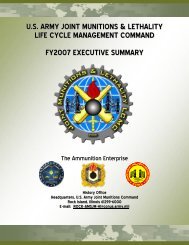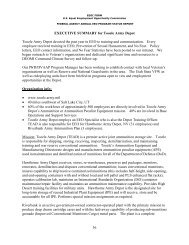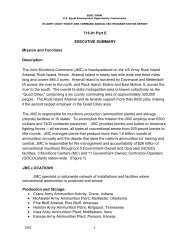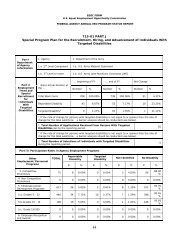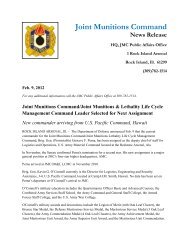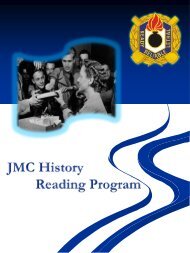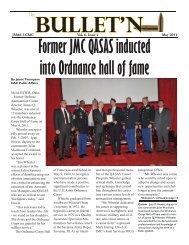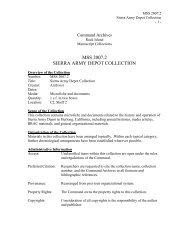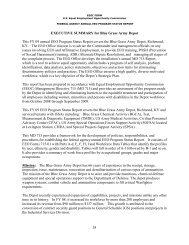History of the Ammunition Industrial Base - JMC - U.S. Army
History of the Ammunition Industrial Base - JMC - U.S. Army
History of the Ammunition Industrial Base - JMC - U.S. Army
Create successful ePaper yourself
Turn your PDF publications into a flip-book with our unique Google optimized e-Paper software.
management. Because <strong>of</strong> <strong>the</strong> lack <strong>of</strong> firm, long range forecasts <strong>of</strong> requirements, it was not<br />
possible to concentrate production in <strong>the</strong> most efficient plants and operate <strong>the</strong>m full time. In late<br />
1943, production load was spread out among many plants to keep <strong>the</strong>m in operation as reserve<br />
against unexpected demands. By winter <strong>of</strong> 1943-1944 many plants were closed. WWII plant<br />
capacity grew to support a 10 million man army and by 1945 it was felt that production capacity<br />
could be reduced by 40% to support a proposed reserve 4.5 million man army.<br />
The Korean Conflict<br />
When <strong>the</strong> Korean War broke out, <strong>the</strong> majority <strong>of</strong> ammunition production plants were shut<br />
down. The Field Service <strong>Ammunition</strong> Division <strong>of</strong> Raritan Arsenal in New Jersey was organized<br />
to accomplish <strong>the</strong> peacetime mission <strong>of</strong> directing supply <strong>of</strong> ammunition to troops for training and<br />
<strong>the</strong> overall operational supervision <strong>of</strong> maintenance and preservation <strong>of</strong> over 7 million tons <strong>of</strong><br />
ammunition in storage. 97 The <strong>Army</strong>‟s munitions production base had declined to 56 ammunition<br />
plants, 40 <strong>of</strong> which were activated to support requirements. The United States had produced<br />
surplus stocks <strong>of</strong> ammunition during World War II, and over 7 million tons <strong>of</strong> ammunition stock<br />
remained in military stockpiles in 1950. 98 There were large stocks <strong>of</strong> most types <strong>of</strong> ammunition<br />
in <strong>the</strong> depots and for <strong>the</strong> first two years <strong>of</strong> fighting troops were issued WWII ammunition stocks.<br />
DoD leaders saw a plentiful stock <strong>of</strong> ammunition, however, various ordnance district <strong>of</strong>ficers<br />
saw <strong>the</strong> need for immediate industrial expansion when <strong>the</strong> war started. Their primary objective<br />
was to reestablish <strong>the</strong> production base and to reactivate ammunition plants.<br />
Optimism about munitions reserves soon faded, and within a few months leaders were<br />
concerned that units in Korea might face shortages. The turning point came in November 1950,<br />
when Communist China entered <strong>the</strong> war. This widened <strong>the</strong> scope and intensity <strong>of</strong> <strong>the</strong> conflict,<br />
leading to a surge in demand for most ammunition types. Consumption <strong>of</strong> ammunition over <strong>the</strong><br />
next two years far exceeded <strong>the</strong> rate planners had expected, as outnumbered U.S. and South<br />
Korean forces relied heavily on firepower to compensate for <strong>the</strong>ir numerical inferiority. For<br />
instance, during <strong>the</strong> Battle <strong>of</strong> Soyang in mid-May 1951, 21 artillery battalions supporting <strong>the</strong> X<br />
Corps fired 309,958 rounds in seven days, well over a thousand tons <strong>of</strong> ammunition per day. In<br />
late August and early September <strong>of</strong> <strong>the</strong> same year, fighting near Inje resulted in <strong>the</strong> use <strong>of</strong> more<br />
than a million rounds <strong>of</strong> 105mm and 155mm ammunition in only 15 days. 99<br />
The supply <strong>of</strong> ammunition during <strong>the</strong> Korean Conflict resulted in many ordnance<br />
challenges. The Ordnance Department faced a unique wartime situation where concepts <strong>of</strong><br />
limited war and police action were new to U.S. wartime policy. Preparedness plans had<br />
historically been based on premises <strong>of</strong> total war experience. According to Dr. C.H. Owens,<br />
author <strong>of</strong> <strong>Industrial</strong> Mobilization Planning in <strong>the</strong> Ordnance Department 1946-1950, <strong>the</strong><br />
industrial mobilization plan in effect for <strong>the</strong> Korean Conflict was inadequate. 100<br />
97 Raymond Snodgrass. <strong>History</strong> <strong>of</strong> Ordnance Activities Relating to <strong>the</strong> Korean Conflict: June 1950-September<br />
1951. (June 1952) , 43.<br />
98 Ibid, 43-44.<br />
99 Mark S. Watson, “<strong>Ammunition</strong> Expenditure in Korea,” Ordnance (September-October 1952): 254. Also reported<br />
in article by CPT David A. Martin, “Artillery <strong>Ammunition</strong> in <strong>the</strong> Korean War” accessed at<br />
www.almc.army.mil/alog/issues/SepOct98/MS297.htm.<br />
100 Dr. C. H. Owens. <strong>Industrial</strong> Mobilization Planning in <strong>the</strong> Ordnance Department: 1946-1950. (March 1956): 47.<br />
Copy located in <strong>JMC</strong> Archives.<br />
33



